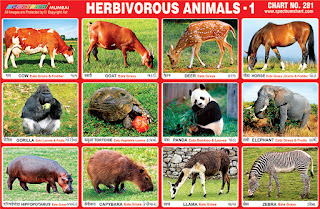Cow
- In India the cow is seen as a sacred animal. Cows are raised as a
dairy animals for milk and other dairy products & as livestock
for meat. Cow is a herbivore. Clover and grass are its
favourite type of food. Cow consumes 40 to 100 pounds of food per day
and drinks 30 to 50 gallons of water.
Goat - Goats are among the earliest animals
domesticated by humans. Goats have been used for their meat, hair,
milk and skins. Goats produce about 2% of the world's total annual
milk supply.
Deer -
Deer are the ruminant mammals forming the family Cervidae. They are
herbivorous animal. Deer have long legs typically suited to the
environments they live in. Male deer grow new antlers each year.
Deer have lifespan of 10 – 20 years.
Horse
- Horses are used by humans for the working activities such as
agriculture, transportation, sports events etc. Horse is a
herbivore. Its diet is based mostly on alfalfa and various grains.
Horse has the biggest eyes of all land mammals and visual field of
nearly 360 degrees. Domestic horses have average lifespan
of between 25 to 30 years.
Gorilla
- Gorillas are large apes that are native to Africa. Gorillas are
herbivores and eat leaves, shoots, roots, vines and fruits. It is
said that the DNA of gorillas is 98-99% identical to human DNA.
Their lifespan ranges between 35 - 50 years.
Tortoise
- Tortoises is a land-dwelling reptile. Tortoises have a hard outer
shell to protect them from predators.The tortoise's shell can range
in size from a few centimetres to a couple of metres, depending on
the species of tortoise. Tortoises have one of the longest lifespans
of any animal, some individuals are known to have lived longer than
150 years.
Panda
- Panda, is a bear native to south central China. It is easily
recognised by the large, distinctive black patches around its eyes,
over the ears, and across its round body. Panda's eats almost
exclusively bamboo in the forest. Their lifespan ranges between 20 –
35 years.
Elephant
- Elephants are the largest land-living mammal in the world.
Elephants are herbivores and can spend up to 16 hours days
collecting leaves, twigs, bamboo and roots. There are two species of
elephant, the Asian elephant and the African elephant. Lifespan of
Elephants is 55 – 70 years.
Hippopotamus
- Hippopotamuses have short legs, a huge mouth and a body shaped
like a barrel. Hippopotamuses spend a large amount of time in water
such as rivers, lakes and swamps. They are herbivores. They
like to eat grass, fallen fruit, sugar cane and corn. Hippopotamus
typically lives for around 45 years.
Capybara
- Capybara live in Central and South America. They like water
and they can be found in swampy areas, near lakes, ponds, rivers.
They have barrel-shaped body covered with brown wiry fur. They are
herbivores. They graze grass and eat aquatic plants most of the
night. They also eat fruit and bark of the tree. Adult animal eats 8
pounds of grass per day.
Llama
- Llama is a close relative of the camel, but without hump. Llamas
originate from South America. Llama's body is covered with wool
which can be black, grey, white or brown, with variety of patterns.
Llamas are herbivores. They eat grass and ferns mainly. Llama on the
farm may eat 6 pounds of hay per day.
Zebra
- Zebra has a unique pattern of black and white stripes. They are
mainly found in Africa. Zebra are part of the equidae family along
with horse and donkeys. They eat grass and leaves. Zebras
can't survive without water and they need to drink it at least once
per day. Their lifespan is 20 –
30 years.


No comments:
Post a Comment